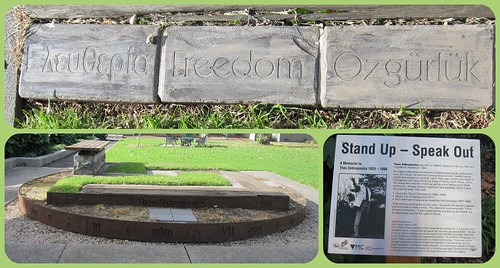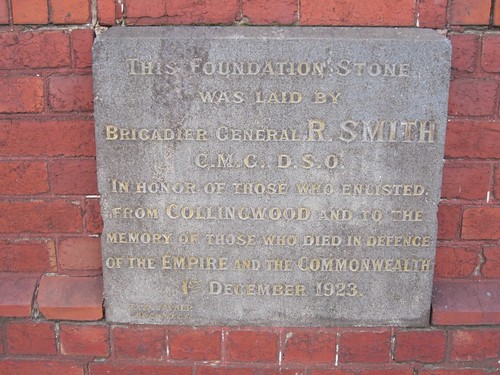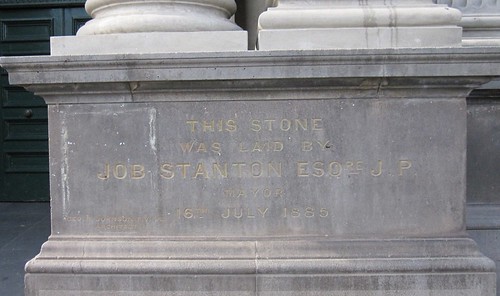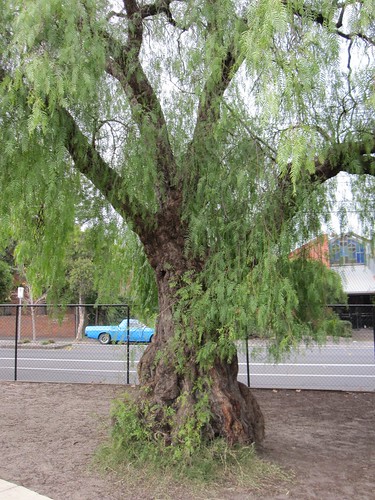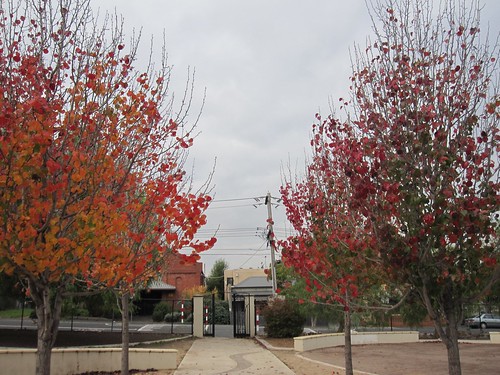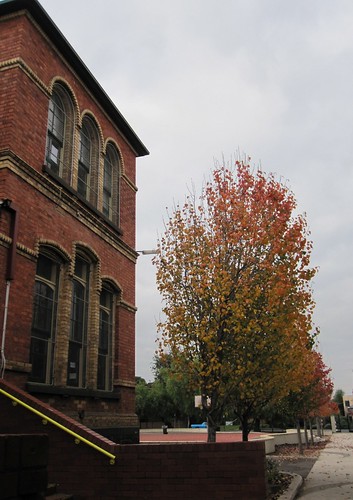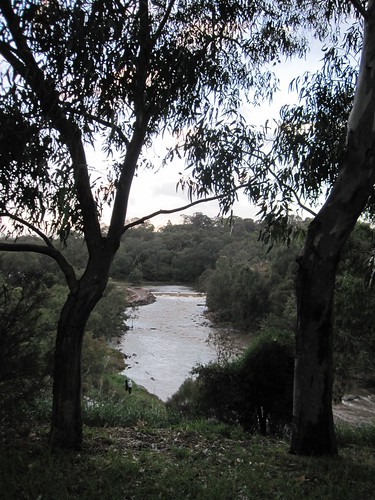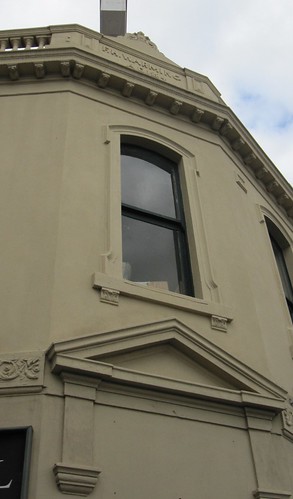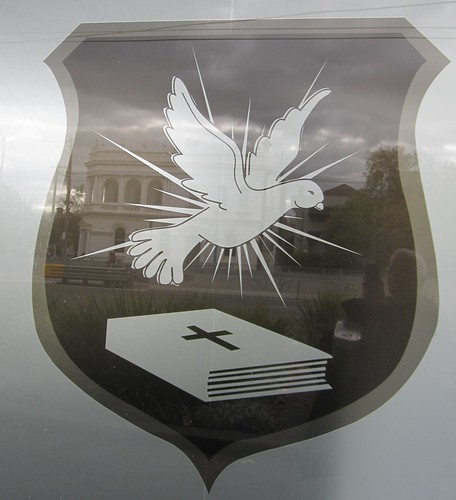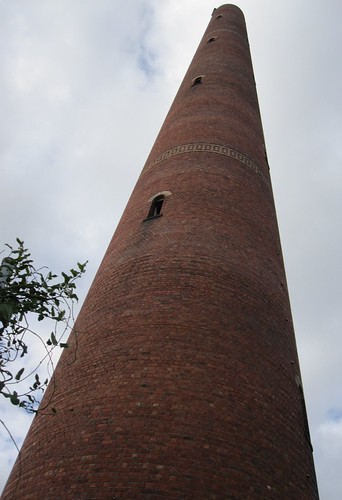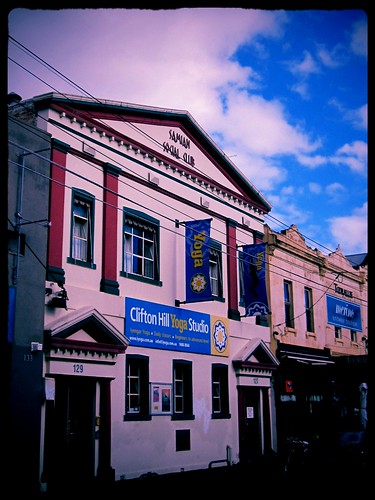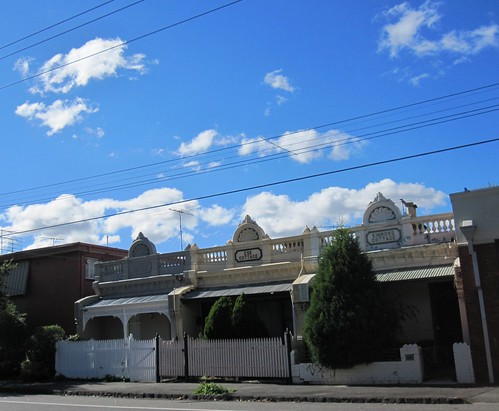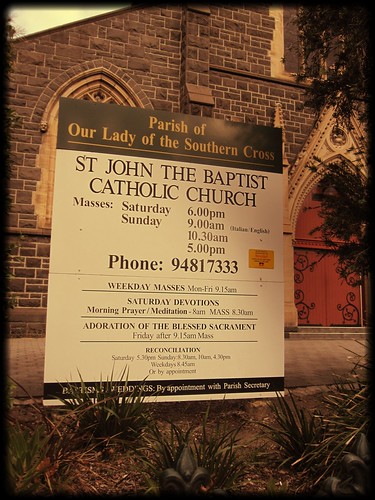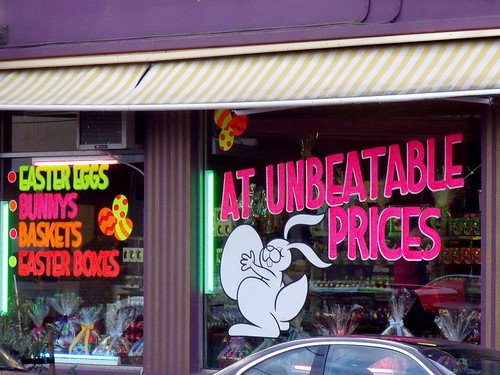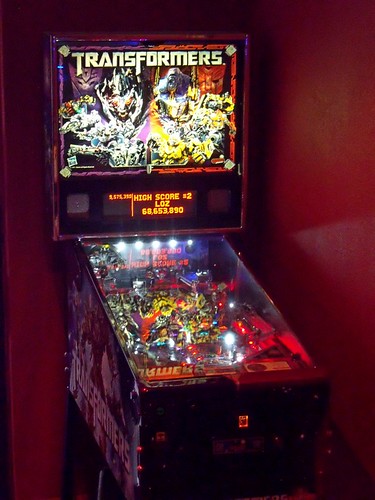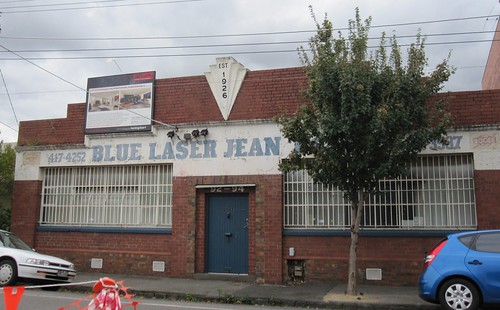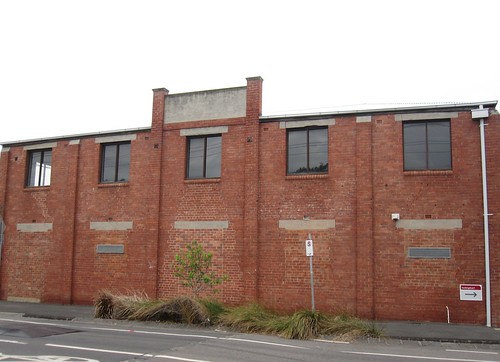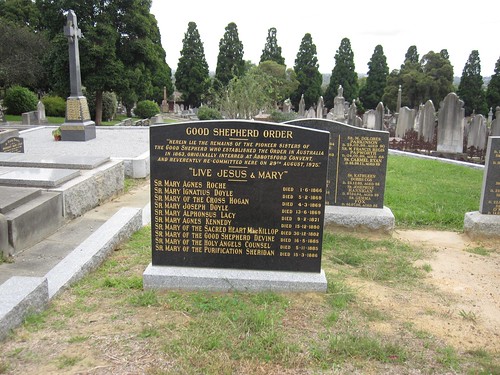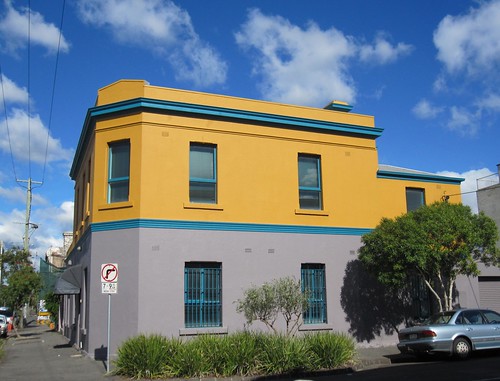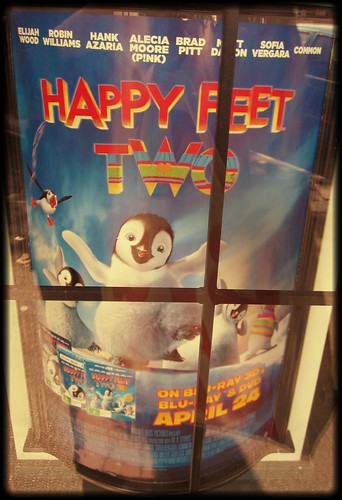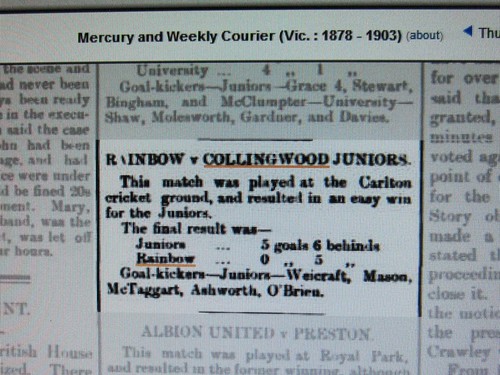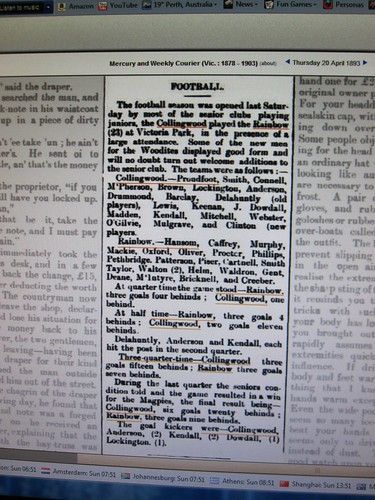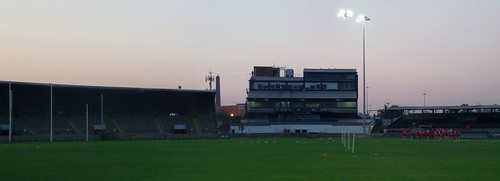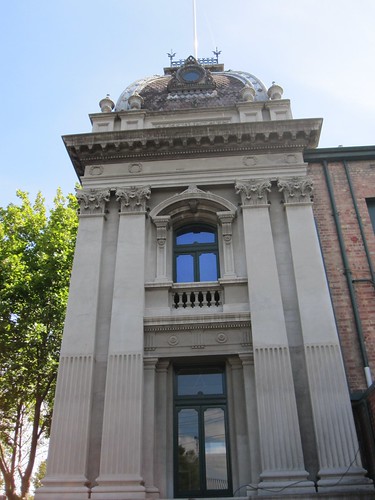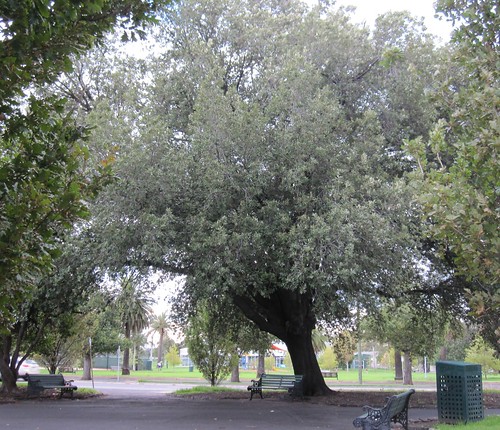Labels
Followers
A blog about the history of the former Melbourne municipality of Collingwood.
31 December 2012
#blog12daysxmas Day 7 End of life 52/52/2
This photo was submitted by the Collingwood Historical Society for the Flickr Friday Photo 2012 Challenge under the theme of "Endings".
30 December 2012
#blog12daysxmas Day 6 Dead end 52/52/1
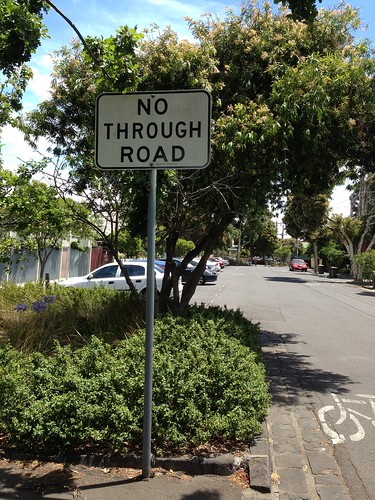
Dead end 52/52/1, a photo by Collingwood Historical Society on Flickr.
Page Street used to run between Gold Street and Wellington Street in Clifton Hill. But traffic management in recent decades has meant that both parts of the street are now dead ends. This shot was taken looking west from Gold Street.
This photo is part of the Collingwood Historical Society's contribution to the Flickr Friday Photo 2012 Challenge.
#blog12daysxmas Day 5 Terminus Hotel 52/52/3
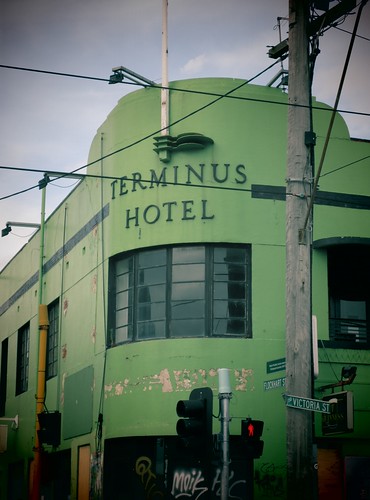
Terminus Hotel, Abbotsford 52/52/3, a photo by Collingwood Historical Society on Flickr.
The Terminus Hotel in Victoria Street Abbotsford (corner of Flockhart Street) has now terminated its services and so is about endings in more way than one. The hotel's name was changed to the Terminus in 1923 to reflect its location near the terminus of the Victoria Street cable-tram at the river, and is on the same site as the previous Brickmakers' Arms Hotel which had been established by 1867. Read about the hotel here.
This photo is part of the Collingwood Historical Society's contribution to the Flickr Friday Photo 2012 Challenge.
28 December 2012
#blog12daysxmas Day 4 Friendly Societies Hotel 52/50/3

Friendly Societies Hotel 52/50/3, a photo by Collingwood Historical Society on Flickr.
As can be seen from the photograph above, the Friendly Societies Hotel in Langridge Street was built in 1889. This building replaced the earlier Langridge Family Hotel which was on the same site from 1870 to 1889. The owner and publican of the new building, William Nicholls, was a member of six friendly societies as well as being a Freemason and the hotel had a large room for lodge meetings. The hotel changed its name to the Carringbush Hotel in 1984, a reference to Frank Hardy's Power without glory where Carringbush is used as a pseudonym for Collingwood, and maybe also a reference to the Carringbush Regional Library which had been established in 1976. There is more information in the Hotels section of this website.
This photo is part of the Collingwood Historical Society's contribution to the Flickr Friday Photo 2012 Challenge.
#blog12daysxmas Day 3 Foresters Hall 1868: Friendly Societies 52/50/2
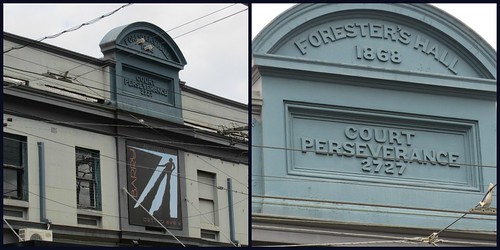
Foresters Hall 1868: Friendly Societies 52/50/2, a photo by Collingwood Historical Society on Flickr.
The former Forester's Hall in Smith Street Collingwood on the northern corner of Langridge was opened in 1868, as the home of the first Victorian branch of the Ancient Order of Foresters. The building with its large space was used for all sorts of local events including court sessions, bazaars and public meetings. The laying of the memorial stone was recorded in the Argus on Wednesday 25 March 1868. You can read the account here.
This photo is part of the Collingwood Historical Society's contribution to the Flickr Friday Photo 2012 Challenge.
#blog12daysxmas Day 2 Friends of the Earth 52/50/1
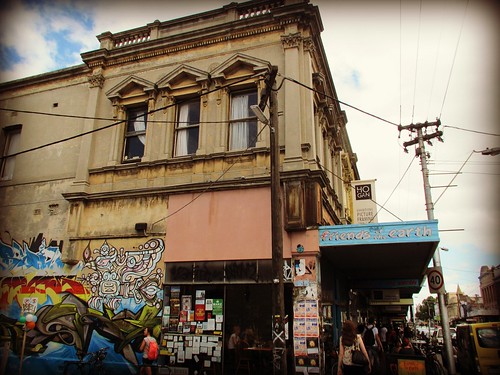
Friends of the Earth 52/50/1, a photo by Collingwood Historical Society on Flickr.
The Friends of the Earth in Smith Street on the southern corner of Perry Street is quite a Collingwood institution. Friends of the Earth (FoE) Australia is a federation of independent local groups working for a socially equitable and environmentally sustainable future.You can find out more about their activities on their website.Their headquarters are on this site in Collingwood where they also operate a cafe and the Collingwood Food Co-Op which first started operation in 1975. Alas, the bookshop that they once operated is no longer here. If you are interested in the history of Friends of the Earth check out the history section of the website.
This photo is part of the Collingwood Historical Society's contribution to the Flickr Friday Photo 2012 Challenge.
#blog12daysxmas Day 1 Collingwood Historical Society Publications
Did you know that the Collingwood historical Society has available for sale a great range of publications about the local history of Abbotsford, Collingwood and Clifton Hill? Amongst others these include Karen Cummings' award-winning history of school in Collingwood, the history of churches in Collingwood and the short history of Collingwood. You can find a full list of them and how to purchase them on the website here.
In December members of the Collingwood Historical Society set up a book stall in Queens Parade Clifton Hill (well actually it was in North Fitzroy), and sold lots of books to passersby. We also enjoyed chatting to people about local history and answering their enquiries.
If you are in Queens Parade and are interested in some local history publications, we have a new outlet for them as the florist, Terrace Gardens 338 Queens Parade, is now stocking them for us! So pop into Terrace Gardens some time and have a look at our publications while you are buying some flowers or plants. Terrace Gardens are open seven days a week.
16 June 2012
06 June 2012
13 May 2012
Banks of the Yarra off Trenerry Crescent 52/20/3
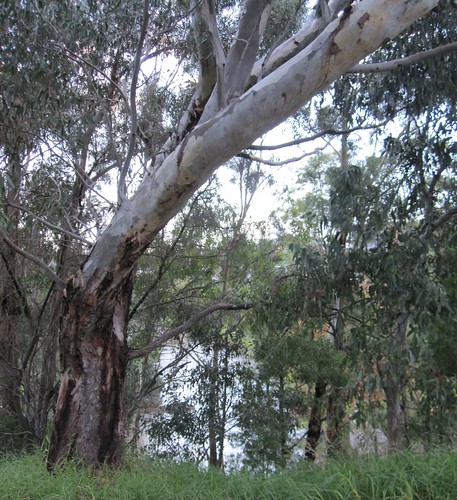
Banks of the Yarra off Trenerry Crescent 52/20/3, a photo by Collingwood Historical Society on Flickr.
This shot of the Yarra and the foliage surrounding the river is typical of much of the river frontage on the Kew part of the river, whilst the Collingwood side was used for industry. This area just south of Dight's Mill and in behind the buildings of Trenerry Crescent is today a little haven from the bustle of the nearby Eastern Freeway and other traffic in the busy inner urban streets surrounding it.

If you want to read further about the Yarra and its history, a good book to start with is Kristin Otto's Yarra: a diverting history of Melbourne's murky river which was published by Text in 2005.
Yarra at Dight's Falls 52/20/2
It is not very easy to get close to Dight's Falls at present due to ongoing "improvement" works in the area and to the falls. However, it was a no brainer to include Dight's Falls in a series of photos about water. Dight's Falls are just east of the confluence of the Merri Creek and the Yarra River and are the furthermost point that boats can navigate upstream from the mouth of the Yarra. The Falls are called after Dight's Mill which was to the left of the photo. Unfortunately the course of both the Yarra and the Merri Creek in this area was changed during the contruction of the Eastern Freeway in the 1970s and it is very difficult to work out what the lie of the land (and water) was before this time.
Yarra Hotel 52/20/1

Yarra Hotel 52/20/1, a photo by Collingwood Historical Society on Flickr.
This photo is submitted by the Collingwood Historical Society as part of the Flickr Friday Photos 2012 challenge under the theme of "water".
Victoria has a number of Italianate hotels built around this period, but the Yarra is an outstanding example due to the scale of its distinctive pediment and rendered ornamentation, which remain largely intact, although the painting of the render work is to be deplored. This black and white photo gives a good sense of what the hotel must have looked like.
06 May 2012
Mr Warming's corner window 52/19/3
The Clifton Hill Hotel prominently situated on the corner of Queens Parade and Wellington Street Clifton has connections to the other two photos in this theme. The hotel which is currently opposite the former St John's Parish Hall was built in 1884 by Frederick Warming whose name can be seen on the parapet above the corner window.
Warming had been the publican of the previous Clifton Hill Hotel which operated a couple of doors to the east from 1872 until 1884 when it was leased to the police after Warming opened his new hotel. The hotel operated in the same location under the name Daniel O'Connell from 1869 to 1871. The site of the hotel before moving to the corner location was probably 105 Queens Parade which was later the residence and rooms of surgeon, J. Forbes Mackenzie.
Surgeon's windows 52/19/2
These windows at 105 Queens Parade Clifton Hill are currently windows at the premises of Clifton Hill and District Chiropractic Clinic. However, for many years 105 Queens Parade Clifton Hill was the residence and rooms of eminent Melbourne surgeon Dr J. Forbes Mackenzie who also practiced as a consulting surgeon at nearby St Vincent's Hospital. Max Meldrum's portrait of Dr Forbes Mackenzie won the 1940 Archibald Prize for portraiture.
Holy Spirit window detail 52/19/1
The window is a detail of one of a number of similar windows on the Queens Parade frontage of former St John's Hall on the corner of Wellington Street. Its exact location is clearly identified by the image in the photograph of the former National Bank building on the opposite corner in North Fitzroy.
The foundation stone for the St John's Catholic Parish Hall was laid by Archbishop Daniel Mannix on 2 September 1917. It replaced four shops which had been between the school and the corner and was opened on 18 April 1918 by the Apostolic Delegate, Archbishop Caltaneo.
That same year yhe premises started life as an early silent movie theatre operated by Robert McLeish who also operated the Northcote, the Austral in Johnston Street Collingwood and the Rivoli in Camberwell. The Clifton cinema was also operated by Hoyts, World Film Distributors and Cinema Italia over the years until it finally closed as a cinema in 1983. After that time it also operated as the Clifton Dance Studio but the hall section of the building was demolished in 1999 and the space was used to provide extra space including a playground for the school.
29 April 2012
Reaching to the clouds 52/18/3
This 160 metre shot tower in Reilly Street (now called Alexandra Parade) and its associated factory was built for Richard Hodgson in 1882 to manufacture lead shot. The tower is all that remains today and is probably the tallest shot tower in Australia. It is circular in plan, looking like a tall chimney, and is a masterpiece of brick construction with finely decorated polychrome patterned brick bands at regular intervals. The semi-circular arched windows are also decorated with polychrome bricks. It is a fine example of a rare and distinctive building type - the only other remaining shot tower is to be found in the Melbourne Central shopping complex. The Alexandra Parade Shot Tower is of State significance and represents an era of industrial growth in the 19th century in Collingwood and the inner suburbs.
Richard Hodgson owned and operated the Lead Shot Works until 1887 after which it was owned by Alfred Harber and Simon Hughes. In 1896 it was purchased by Walter Coop, who also operated the Melbourne Central shot tower. It belonged to the Coop family for 90 years and remained in use until 1947.
Lead shot was made by melting the lead at the top of the tower and then pouring it through a perforated sheet which separated the flow of molten lead into streams. It was then broken up to form droplets. The droplets were shaped and solidified as they fell from the top of the tower, and were cooled by dropping into a trough of water at the bottom of the tower. The shot was then shovelled out of the water trough, dried and rolled down a stepped, inclined table. Undamaged shot cleared the step while damaged shot dropped through a gap at the bottom of the step and was remelted. The round shot was sieved to size and then polished in a rotating barrel for one and a half hours before being sewn into 13 kilogram hessian bags and taken to the munitions factory at Deer Park, in the west of Melbourne.
The Shot Tower is a landmark of Clifton Hill and was used by pilots flying into Essendon Airport as a visual marker to their location.
The Shot Tower is on the Victorian Heritage Register (H0709) and is classified by the National Trust (B3798)
Samian Social Club 52/18/2
In July 1890 the Clifton Hill Baptist Church commenced services here and operated from the Albert Hall until its church was opened around the corner in Hodgkinson Street in 1895. The hall was rebuilt in 1927 when a stone was laid in January commemorating 40 years of the lodge.
In the 19th and early 20th century while it was the Albert Hall, the facility was regularly used for community meetings and for prize nights for local schools such as the Misses Westgarth's Westleigh school.
28 April 2012
Clouds, cottages, Collingwood 52/18/1
These cottages, named Dalkeith, Esk and Kinross, are on the east side of Wellington Street just north of Keele Street and their local drinking hole would have been the Phoenix Hotel on the corner of Keele Street though the residents would not have had to walk far for another hotel if they wanted a change. The cottages are outlined below on the 1900 Melbourne and Metropolitan Board of Works map where you can see that Esk and Kinross have baths and troughs. The cottages appear to have been built about 1883 from Sands and McDougall records.
St Nicholas' Croatian Catholic Church Clifton Hill 52/15/3
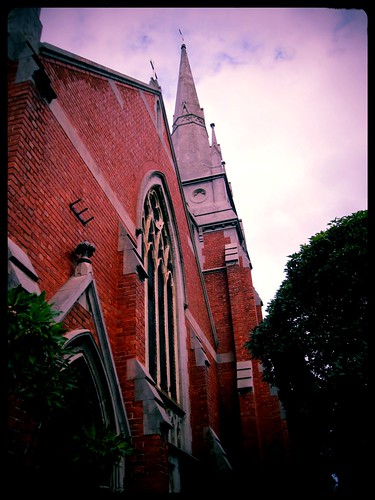
St Nicholas' Croatian Catholic Church Clifton Hill 52/15/3, a photo by Collingwood Historical Society on Flickr.
Pictured here is St Nicholas' Croatian Catholic Church in Hodgkinson Street, Clifton Hill. As with its Roman Catholic counterpart in Queens Parade it was not possible to find any sign of Easter services at the church.
The church was originally a Wesleyan Methodist church whose foundation stone was laid in 1886, though there was a church on the site from the mid 1870s which possibly survives in the oldest part of the hall. The parsonage was built in 1881.
Due to lack of attendance, the Methodist church closed down in 1961 and was purchased by the Croatian Catholic community who have made it a thriving religious and cultural community.
St John's on Holy Saturday 52/15/2
You would have been hard pressed to discover the time of Easter services at the church of St John the Baptist in Clifton Hill - or any sign of Easter really. Presumably they would have been the same at the normal 6pm Saturday Vigil mass as a later dialogue on Twitter indicated.
Chocolate Paradise Pty Ltd 52/15/1
This shop at 312-314 Johnston Street, Abbotsford, has long been a tempting destination for those with a sweet tooth. Easter is one of its busiest times.
Photo by Pat Miller
Multi-Game 52/14/2
Photo by Pat Miller
Transformers Pinball 52/14/3
The many hotels in the Collingwood area have long been the focus for local games. Traditional games, such as darts, have now given way to games such as this electronic pinball machine In the red games room at the Park Hotel, Nicholson St., Abbotsford.
Photo by Pat Miller
Former Whybrows Boot Factory 52/13/3
Whybrows whose boot factory still stands in Hoddle Street Abbotsford was a big employer in Collingwood. Born of illiterate Irish immigrants in Ballarat St, Collingwood in 1871, John Wren like many Collingwood boys commenced his working life in the boot trade, working at Whybrows boot factory. Some stories say that while there he added to his income by a small scale bookmaking operation; others suggest that he worked for a bookie after his retrenchment from Whybrows in the 1891/1892 economic slump; another story is that it was a win on the Melbourne Cup that allowed him to set up business in Johnston Street. Whatever the truth of all of this John Wren was typical of many a Collingwood youth that he started his working life at Whybrows.

This photo dated to about 1920 is from the Museum of Victoria and shows the clipping room at Whybrows where the tops of shoes were cut out. John Wren would have been unlikely to have worked in this room as a skilled clipper.
Former Moderne style shoe factory 52/13/2
92-94 Easey Street Collingwood provides this well-preserved brick and render factory in Moderne style, with distinctive details such as the sunburst keystone, doorway, stepped parapet and string mould.
Built 1933 for Norman Trescowthick, a well-known name in Collingwood boot industry, it was let it to Aristocrat Shoes Pty Ltd and later housed C J Braun and Co shoe manufacturers.
Former Trueform Boot Factory 52/13/1
In the 19th century Collingwood became known as the capital of Australia's boot and shoe manufacturing industry. At the start of the 1900s south-east Clifton Hill was a mix of houses, factories and paddocks. Boot and shoe factories developed in east Clifton Hill from the 1900s and there were a large number operating in the 1920s and 1930s. The last closed down in the 1970s.
The Sands and McDougall Directories list businesses in the area over the years. The first listing on the Groom Street frontage was the Pitman Shoe Company in 1917 (37-41 Groom St). In 1923 Halsey and Son, boot manufacturers, had arrived, to be replaced in 1924 by Trueform Boot and Shoe Co Pty Ltd. The Trueform Boot and Shoe Company were listed at 43 Groom Street until 1936, but by 1938 had gone into liquidation and had been replaced by A Pattison and Co., furniture manufacturers.
This photo is one of the Collingwood Historical Society's contributions to the Flickr Friday Photos 2012 challenge under the theme of Shoes.
Alan Marshall worked as an accountant at the factory during the early 1930s Depression and vividly recorded life in the factory in his autobiographical novel How beautiful are thy feet. The book was first published in 1949 and refers to the factory as the 'Modern Shoe Company'.
Pioneer Abbotsford nuns 52/12/3
The gravestone photographed here is not in Collingwood but honours the ten Good Shepherd nuns who established the order in Australia in 1863 at Abbotsford. The nuns were originally buried at the Abbotsford Convent but in 1975 were reburied here in the order's burial ground in the Boroondara Cemetery at Kew.
Former Phoenix Hotel 52/17/2
There isn't much wildlife around Collingwood - or at least I didn't see much this week. This connection is a bit of a stretch of the imagination and an assumption that a phoenix was wildlife, albeit mythical wildlife.
The building shown here which is on the south west corner of Keele and Wellington Streets in Collingwood is the former Phoenix Hotel. The hotel started life in 1875 as the Woodthorpe Hotel but from 1885 to 1919 it traded as the Phoenix Hotel. It was delicensed in 1919.
Nowadays the corner door opening has been filled in and the ground floor window frames altered, but otherwise Michael Torpey, publican from 1887 until 1892, could return to his hotel today and have no trouble recognising the exterior, although he might be a little surprised by the paint colours.
21 April 2012
Wildlife in Clifton Hill 52/17/1
There isn't much in the way of wildlife per se in the former municipality of Collingwood, but these penquins were spotted on display in the video shop in Queens Parade this morning!
15 April 2012
Easy win over the Rainbows 52/16/2
Magpies beat the Rainbow! 52/16/1
05 April 2012
25 March 2012
Bernadou grave at Boroondara Cemetery 52/12/2
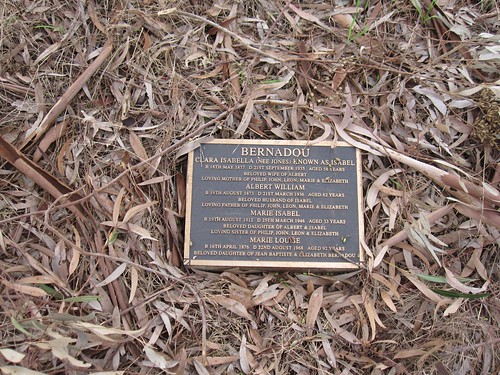
Bernadou grave at Boroondara Cemetery 52/12/2, a photo by Collingwood Historical Society on Flickr.
This photo is one of the Collingwood Historical Society's contributions to the Flickr Friday Photos theme of "Cemeteries".
As stated in the previous post, the area of Collingwood had no cemetery of its own so its residents tend to be buried either in Melbourne General Cemetery in neighbouring Carlton or in Boroondara Cemetery up the hill in Kew.
Marie Louise Bernadou is an example of someone with a Collingwood connection who is buried in Kew. As can be seen from the plaque she is buried her with her brother and sister-in-law and some of their family in the Church of England section of the cemetery. Her parents, Jean-Baptiste and Elizabeth, are also buried in the cemetery but in the Baptist section.
Marie Louise lived as a child with her French carpenter father and his English wife in Mason Street Collingwood. She won a scholarship to the Presbyterian Ladies College and after matriculating entered the University of Melbourne and graduated in 1897 with first class honours. Her graduation photo is shown below.

Marie Louise worked as a governess and a Matriculation coach and taught French at King's College in North Terrace, Clifton Hill. Later she completed a Diploma of Education and joined the Education Department. There is further information about Marie Louise in the Collingwood Historical Society history of schools, Bitter Roots, Sweet Fruit.
18 March 2012
Roman Catholic section at north of Melbourne General Cemetery 52/12/1

Roman Catholic section at north of Melbourne General Cemetery 52/12/1, a photo by Collingwood Historical Society on Flickr.
This photo is part of the Flickr Friday Photo group under the theme of "Cemeteries".
The municipality of Collingwood does not have a cemetery within its boundaries. As a result of this those connected with Collingwood are most commonly buried in either the Melbourne General Cemetery in neighbouring Carlton to the west or at the Boroondara Cemetery to the east in Kew.
The photograph shows the Roman Catholic section at the north of the Melbourne General Cemetery. Unfortunately the cemetery website is currently "under development" so we can't show any specific graves with Collingwood connections. But we do know that there were Catholics in Collingwood from early days as is evidenced by the early establishment of St Joseph's in Otter Street. A number of hoteliers were Catholic and some had memorial glass in St Joseph's. Most likely they would have been buried here.
One interesting Collingwood character whom we do know to be buried here is Eliza "Granny" Foster who probably staked John Wren when he first set up the Tote. She certainly owned the property. When she died in July 1913, Wren's refusal to accept her estate made headlines. "Granny" Foster died in Hodgkinson Street Clifton Hill and was buried in Melbourne General Cemetery.
12 March 2012
Collingwood United Masonic Temple
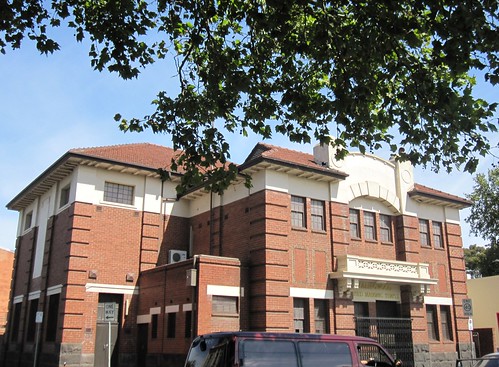
Collingwood United Masonic Temple, a photo by Collingwood Historical Society on Flickr.
This photo is part of the Flickr Friday Photos 2012 group under the theme 'Craft".
Architectural evidence of the Arts and Crafts movement is not very prevalent in a predominantly 19th century place such as Collingwood. But there are some examples. Collingwood United Masonic Temple was built in 1928/9 at 141 Gipps Street, Abbotsford, by Freemason architect, Bro. Harry Little and builders Morison Bros Pty Ltd. the heritage citation for it states: "The hipped terracotta tiled roof has projecting eaves, imparting an Arts and Crafts feel".
For more information about the building check out the full entry in the City of Yarra Heritage database.
Yarradale Flats
This photo is part of the Flickr Friday Photos 2012 group under the theme "Craft".
Yarradale Flats were built at 29 Clarke Street Abbotsford for Daniel Keir in 1926. Yarradale is of local architectural significance as one of very few blocks of flats in the former City of Collingwood dating from the interwar years. It displays influences of the Arts & Crafts Movement, notably in the clink brick arched entrance.
For further information check out the City of Yarra Heritage database.
Craftsman Larry Harrigan's work 52/11/1
This photograph is part of the Flickr Friday Photos 2012 group under the theme of "Craft".
We don't know much about the many craftsmen who would have worked on the building of Collingwood Town Hall. But we do know about the work of Master Plasterer Larry Harrigan who worked on the restoration of the building in the 1980s.
This photo of the south east corner of the building shows many examples of work that needed the hands of a skilled craftsman like Larry. Examples of this are the capitals of the columns, the window arch, the parapet in front of the window and the urns on top.
There are a number of photos of Larry at work. You can see them here. There is also a DVD about him available at Collingwood Library. One of them is shown below where he puts the finishing touches to a cement-rendered urn similar ro those in the photograph at the beginning of the post.
Darling Gardens Clifton Hill 52/10/3
Like nearby Raines Reserve, Darling Gardens permanently reserved by Order 12 December 1866 is one of three sites in the former City of Collingwood to be featured on the National Trust Tree Register. The third site is the grounds of the Abbotsford Convent.
Darling Gardens has two trees on the register a holm oak (quercus ilex) of regional significance in an historic garden or park and an English elm (ulmus procera). The elm's context is also an historic garden but is considered an outstanding example of the species and its estimated age in February 2011 was given as about 120 years.
Plants were provided initially by von Mueller and later early plantings had their origin in Scott's nursery in Hawthorn.
Mayors' Park in late afternoon 52/10/2
This photo of part of the Flickr Friday Photos 2012 group under the theme "Green".
Like the previous reserve, Raines, Rain's or Raines Reserve, this nearby Reserve has also suffered from spelling aberrations. It appears these days in Melways and Google as "Mayors" Park. But in the 1897 MMBW map it appears as Mayor's and for some reason I had always thought as it was celebrating Mayors of Collingwood that it would be Mayors' but maybe it was meant to celebrate the Mayor of the day only. The Park appears in the 1869 de Gruchy map as Mayor's Park and appears always to have been allocated as a reserve.
Raines Reserve 52/10/1
This photo is part of the Flickr Friday photos 2012 group under the theme "green".
Raines Reserve is the current name of a small reserve in Clifton Hill at the junction of Heidelberg Road and Queens Parade and leading to the former United Kingdom Hotel. It was called after Cr William Rain who was Mayor of Collingwood in 1904/5 and more properly should be called Rain's Reserve but as time has passed the spelling has changed. Rain was a long term member of Collingwood Council and Chairman of the Council Public Works Committee as well as a Commissioner of the MMBW. An architect by profession he was born in Geelong but lived in Collingwood for most of his life. In parallel to his time on Collingwood Council he was also for a time a Councillor and Shire President for Dandenong.
Rain's Reserve is not shown in Kearney, de Gruchy, or the MMBW maps featuring Collingwood but is on the 1921 map (go to Maps Online section of Collingwood Historical Society website). The Sands and McDougall directories need more research but because of the nature of the site that part of Collingwood is not always easy to find so we are not really sure when this Reserve came into being and when it was named.
The Collingwood Historical Society has one historical photo of the reserve. This photo represented below is probably dated between 1912 and 1917 because of the businesses shown. You can see that the layout of the Reserve has changed in recent times with the central pathway now going right through to the apex.
The holm oak or Quercus Ilex shown in the photograph at the top of the post is one of the few trees in the former City of Collingwood that is included in the National Trust Tree Register as being of Regional Significance. In another quirk of spelling the National Trust Register spells the name of the reserve as "Raine's" and places the Reserve on the intersection of Queens Parade and Alexandra Parade. The Reserve is otherwise not named on Google maps.
If you have any further information about Raines Reserve or William Rain we would love to hear from you.
Total Pageviews
FEEDJIT Live Traffic Feed
Blog Archive
-
▼
2012
(55)
-
▼
December
(7)
- #blog12daysxmas Day 7 End of life 52/52/2
- #blog12daysxmas Day 6 Dead end 52/52/1
- #blog12daysxmas Day 5 Terminus Hotel 52/52/3
- #blog12daysxmas Day 4 Friendly Societies Hotel 52/...
- #blog12daysxmas Day 3 Foresters Hall 1868: Friendl...
- #blog12daysxmas Day 2 Friends of the Earth 52/50/1
- #blog12daysxmas Day 1 Collingwood Historical Socie...
-
►
April
(17)
- Reaching to the clouds 52/18/3
- Samian Social Club 52/18/2
- Clouds, cottages, Collingwood 52/18/1
- St Nicholas' Croatian Catholic Church Clifton Hill...
- St John's on Holy Saturday 52/15/2
- Chocolate Paradise Pty Ltd 52/15/1
- Multi-Game 52/14/2
- Transformers Pinball 52/14/3
- Former Whybrows Boot Factory 52/13/3
- Former Moderne style shoe factory 52/13/2
- Former Trueform Boot Factory 52/13/1
- Pioneer Abbotsford nuns 52/12/3
- Former Phoenix Hotel 52/17/2
- Wildlife in Clifton Hill 52/17/1
- Easy win over the Rainbows 52/16/2
- Magpies beat the Rainbow! 52/16/1
- Dusk over Victoria Park 52/14/1
-
▼
December
(7)



